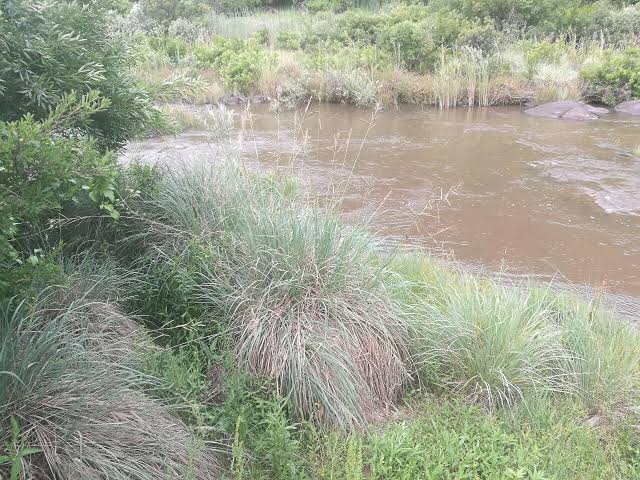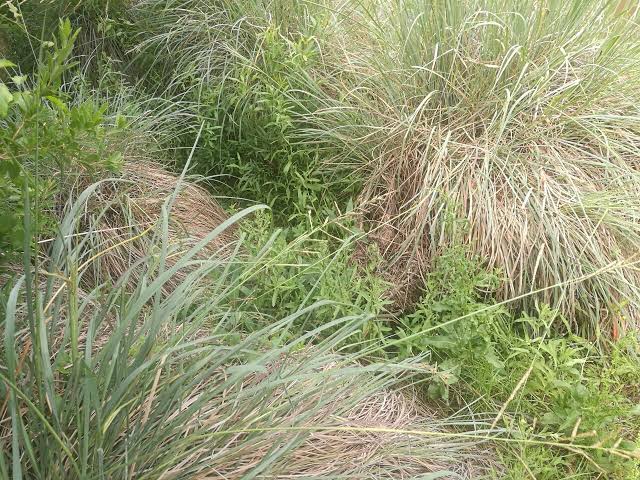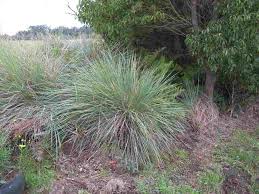Tussock paspalum (Paspalum quadrifarium) is a type of grass that grows in many places around the world. This grass is known for its unique characteristics and adaptability to different environments. Let’s explore some key aspects of Tussock paspalum.
Firstly, Tussock paspalum is recognized for its tufted or clumped growth habit. It forms dense bunches, creating a distinctive appearance in the landscape. The grass blades are long and slender, contributing to the tussock-like structure.
One of the remarkable features of Tussock paspalum is its ability to thrive in various soil types. Whether it’s sandy soils or clayey ones, this grass demonstrates resilience and can adapt well to different conditions. This adaptability makes it a valuable species in landscaping and erosion control efforts.
Tussock paspalum is often found in coastal areas, including salt marshes and estuaries. Its tolerance to saline conditions makes it well-suited for environments where other grasses may struggle to survive. This characteristic has led to its use in coastal restoration projects and golf course landscaping, particularly in regions with high salinity levels in the soil.
Beyond its environmental adaptability, Tussock paspalum is valued for its lush green appearance. The grass creates a visually appealing landscape, and its tufted growth pattern adds a touch of natural beauty to the surroundings. This aesthetic quality makes it a preferred choice for ornamental purposes in gardens and parks.
In terms of maintenance, Tussock paspalum is known for being relatively low-maintenance compared to some other grass varieties. It can tolerate mowing well and does not require excessive care, making it an attractive option for landscaping projects where ease of maintenance is a priority.
The grass also serves ecological functions, providing habitat and food for various wildlife species. Its presence contributes to the overall biodiversity of ecosystems, creating a balanced environment for both flora and fauna.
Tussock paspalum, scientifically known as Paspalum quadrifarium, stands out for its tufted growth, adaptability to different soils, and resilience in saline conditions. Its aesthetic appeal, low-maintenance characteristics, and ecological contributions make it a versatile choice for landscaping and environmental restoration projects worldwide.
Read Also: How to Grow and Care for Pumpkin Fruit
How To Grow Tussock Paspalum (Paspalum quadrifarium)

Growing Tussock paspalum (Paspalum quadrifarium) can be a rewarding experience, and with a few key considerations, you can cultivate a healthy and vibrant stand of this grass. Here’s a simple guide on how to grow Tussock paspalum:
1. Site Selection: Choose a planting site that receives an adequate amount of sunlight. Tussock paspalum generally thrives in full sun but can tolerate partial shade. Ensure the soil is well-draining to prevent waterlogging, as excessive moisture can adversely affect the grass.
2. Soil Preparation: Prepare the soil by loosening it with a garden fork or tiller. Tussock paspalum is adaptable to various soil types, but it prefers a slightly acidic to neutral pH. Adding organic matter, such as compost, can improve soil structure and fertility.
3. Planting: Plant Tussock paspalum seeds or sod in the desired location. Planting in the early spring or fall is generally ideal for grass establishment. Ensure proper spacing between plants to allow for the tussock-like growth habit.
4. Watering: Water the newly planted grass regularly to keep the soil consistently moist during the initial establishment period. Once established, Tussock paspalum is moderately drought-tolerant but benefits from occasional watering during dry periods.
5. Fertilization: Apply a balanced fertilizer with a ratio like 10-10-10 during the growing season to promote healthy growth. Follow the recommended application rates on the fertilizer package, and avoid over-fertilizing, as this can lead to excessive thatch buildup.
6. Mowing: Keep Tussock paspalum at the desired height by mowing regularly. Maintain a mowing height of around 2 to 3 inches for a neat and healthy appearance. Avoid cutting more than one-third of the grass height in a single mowing session.
7. Weed Control: Monitor the area for weeds, and promptly remove any unwanted vegetation. Applying a pre-emergent herbicide in the spring can help prevent weed growth. However, be cautious with herbicide use, and follow recommended guidelines.
8. Pest and Disease Management: Keep an eye out for pests and diseases that may affect Tussock paspalum. Common pests include grasshoppers and certain types of caterpillars. Use appropriate insecticides if pest populations become problematic. Disease prevention involves maintaining good air circulation and avoiding overwatering.
9. Winter Care: In colder climates, Tussock paspalum may experience some browning during the winter. This is generally normal, and the grass often regains its green color in the spring. Provide a layer of winter mulch if necessary to protect the grass from extreme cold.
10. Regular Maintenance: Regularly assess the overall health of the Tussock paspalum stand. Address any issues promptly, and perform routine maintenance tasks such as dethatching if needed.
By following these general guidelines, you can create an environment conducive to the healthy growth of Tussock paspalum, resulting in a lush and attractive grass stand.
How To Care For Tussock Paspalum (Paspalum quadrifarium)
Caring for Tussock paspalum (Paspalum quadrifarium) involves a combination of practices that promote its health, appearance, and resilience. Here’s a guide on how to care for Tussock paspalum:
1. Watering: Ensure consistent moisture for Tussock paspalum, especially during periods of drought. Water deeply and infrequently rather than shallow and often. Adequate watering helps establish a robust root system.
2. Fertilization: Apply a balanced fertilizer during the growing season to provide essential nutrients. Follow recommended application rates, and consider a soil test to determine specific nutrient needs. Avoid excessive fertilizer, as it can lead to thatch buildup.
3. Mowing: Maintain a regular mowing schedule to keep Tussock paspalum at the desired height. Set the mower at a height of 2 to 3 inches to encourage healthy growth. Avoid cutting more than one-third of the grass height at a time to prevent stress.
4. Thatch Management: Monitor thatch accumulation, and dethatch the lawn if it becomes excessive. Thatch can hinder water and nutrient penetration to the soil, affecting the grass’s overall health.
5. Weed Control: Keep an eye out for weeds and promptly remove them. Apply pre-emergent herbicides in the spring to prevent weed growth. Spot treat with post-emergent herbicides if weeds become a significant issue.
6. Pest Management: Monitor for pests such as grasshoppers or caterpillars. Use insecticides when necessary, following recommended guidelines. Beneficial insects and natural predators can also help control pest populations.
7. Disease Prevention: Ensure proper air circulation by avoiding excessive thatch and maintaining the recommended mowing height. Water early in the day to allow the grass to dry before evening, reducing the risk of fungal diseases.
8. Aeration: Periodically aerate the soil to alleviate compaction and improve water and nutrient absorption. Aeration promotes a healthy root system and enhances overall turf vigor.
9. Winter Care: In colder climates, Tussock paspalum may experience some winter browning. While this is typically temporary, consider providing a layer of winter mulch to protect the grass from extreme cold.
10. Regular Inspection: Regularly inspect the lawn for any signs of stress, discoloration, or irregular growth. Address issues promptly to prevent them from escalating and impacting the overall health of the grass.
11. Irrigation Management: Adjust irrigation practices based on seasonal weather conditions. During periods of rainfall, reduce supplemental irrigation to prevent overwatering.
12. Environmental Considerations: Be mindful of the local climate and environmental conditions. Adjust care practices based on factors such as temperature, humidity, and any unique challenges presented by the specific geographic location.
By incorporating these care practices into your routine, you can help maintain the health and vitality of Tussock paspalum, ensuring a lush and attractive lawn or landscape.
Read Also: How to Grow and Care for Grapefruits
The Uses of Tussock Paspalum (Paspalum quadrifarium)

Tussock paspalum (Paspalum quadrifarium) serves various practical and ecological purposes, making it a versatile grass with several uses. Here are some notable applications:
1. Landscaping and Ornamental Purposes: Tussock paspalum is often used in landscaping for its attractive tufted growth habit and lush green appearance. Its aesthetic qualities make it a popular choice in gardens, parks, and other ornamental settings, contributing to visually pleasing landscapes.
2. Erosion Control: Due to its adaptability and ability to establish in various soil types, Tussock paspalum is employed for erosion control projects. The dense root system helps stabilize soil, preventing erosion in areas susceptible to water runoff or wind.
3. Coastal Restoration: This grass is well-suited for coastal regions and is often utilized in restoration projects along shorelines. Its tolerance to saline conditions makes it valuable for stabilizing sandy soils in coastal environments.
4. Golf Course Turf: Tussock paspalum is favored for use on golf courses, particularly in regions with high salinity in the soil. Its ability to thrive in coastal areas and withstand saline conditions makes it a suitable choice for creating resilient and attractive turf on golf courses.
5. Pasture and Forage: In some regions, Tussock paspalum is utilized as forage for livestock. It provides a nutritious feed option for grazing animals, contributing to their overall diet. Its adaptability to different soil types makes it a practical choice for pastureland.
6. Soil Improvement: The deep root system of Tussock paspalum helps improve soil structure and aeration. As the grass grows, it contributes organic matter to the soil, enhancing its fertility and overall health.
7. Wildlife Habitat: Tussock paspalum provides habitat and food for various wildlife species. The dense tufted growth offers shelter for small animals and insects, contributing to the overall biodiversity of ecosystems where it is established.
8. Low-Maintenance Landscapes: This grass is known for its relatively low maintenance requirements. It can be an ideal choice for landscaping projects where ease of care is a priority, such as in public spaces or commercial developments.
9. Green Infrastructure: Tussock paspalum is included in green infrastructure projects aimed at enhancing environmental sustainability. Its role in stabilizing soil, preventing erosion, and providing green cover aligns with efforts to create more environmentally friendly urban and rural spaces.
10. Reclamation of Disturbed Areas: In areas that have been disturbed by construction or other activities, Tussock paspalum can be planted to aid in the reclamation process. Its adaptability allows it to establish and thrive in disturbed soils.
In additionally, Tussock paspalum serves a range of purposes, from enhancing landscapes with its ornamental appeal to contributing to ecological restoration and sustainable land management practices. Its versatility makes it a valuable asset in various settings, meeting both aesthetic and functional needs.
Frequently Asked Questions (FAQs)
Q: What is Tussock paspalum (Paspalum quadrifarium)?
A: Tussock paspalum, scientifically known as Paspalum quadrifarium, is a type of grass known for its tufted or clumped growth habit. It is valued for its adaptability to different soil types and its ability to thrive in coastal and saline environments.
Q: Where is Tussock paspalum commonly found?
A: Tussock paspalum is found in various regions worldwide. It is often located in coastal areas, salt marshes, estuaries, and is used in landscaping, erosion control, and on golf courses, especially in regions with high soil salinity.
Q: Can Tussock paspalum be used for landscaping?
A: Yes, Tussock paspalum is frequently used in landscaping due to its attractive tufted growth and lush green appearance. It adds aesthetic value to gardens, parks, and other ornamental settings.
Q: How do I grow Tussock paspalum in my lawn?
A: To grow Tussock paspalum, choose a sunny location with well-draining soil. Plant seeds or sod in the early spring or fall, water regularly during establishment, and maintain proper mowing and fertilization practices.
Q: Is Tussock paspalum suitable for coastal areas?
A: Yes, Tussock paspalum is well-suited for coastal regions as it can tolerate saline conditions. It is often used in coastal restoration projects and on golf courses near the coast.
Q: What are the maintenance requirements for Tussock paspalum?
A: Regular watering, balanced fertilization, proper mowing, and occasional aeration are key maintenance tasks. Monitoring for pests, diseases, and addressing issues promptly contribute to the overall health of Tussock paspalum.
Q: Can Tussock paspalum be used for erosion control?
A: Yes, Tussock paspalum is effective for erosion control due to its dense root system. It stabilizes soil, making it suitable for preventing erosion in areas prone to water runoff or wind.
Q: Is Tussock paspalum suitable for golf course turf?
A: Yes, Tussock paspalum is commonly used on golf courses, especially in coastal areas. Its ability to thrive in saline conditions makes it a resilient and attractive turf option.
Q: Does Tussock paspalum provide habitat for wildlife?
A: Yes, Tussock paspalum contributes to wildlife habitat by providing shelter and food for various species. Its dense tufted growth supports biodiversity in ecosystems where it is established.
Q: Can Tussock paspalum be used as forage for livestock?
A: Yes, Tussock paspalum is utilized as forage in some regions, providing a nutritious feed option for grazing animals and contributing to pastureland.
Read Also: Top 20 Proven Benefits of Ginger Plant

